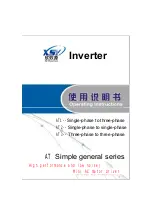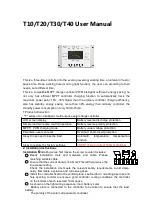
12
Three Phase Emergency Lighting Inverter User’s Manual
#018-7002-00
1.2.2.
UPS MODULE CABINET - The metal enclosure which contains the Rectifier / Charger, Inverter, Static
Transfer Switch, Internal Bypass line, operator controls, batteries (up to 30kVA models only) and internal
control systems required to provide specified AC power to a load.
1.2.3.
UPS MODULE - The Rectifier / Charger and Inverter assemblies which, under the direction of the inter-
nal control system and operator controls, provide specified AC power to a load.
1.2.4.
RECTIFIER / CHARGER - The UPS components which contain the equipment and controls neces-
sary to convert input AC power to regulated DC power required for battery charging and for supplying
power to the Inverter.
1.2.5.
INVERTER - The UPS components which contain the equipment and controls necessary to convert
DC power from the Rectifier / Charger, or the battery, to AC power required by the critical load.
1.2.6.
STATIC TRANSFER SWITCH - The device that connects the critical load to the bypass line when
the Inverter cannot supply continuous power.
1.2.7.
BYPASS LINE - The line, which conducts electricity directly from the input power source to the critical
load during Maintenance or whenever the UPS is not completely operational.
1.2.8.
AC INPUT POWER - Is the power provided by the electrical utility company, or auxiliary generator, which
is connected to the UPS for supplying the critical load and recharging the battery.
1.2.9.
BATTERY - The rechargeable battery strings that supply DC power to the inverter to maintain con-
tinuous AC power to the load during AC input power failure conditions.
1.3 THEORY OF OPERATION
1.3.1. Standby Mode
After power is applied, the system is placed in STANDBY mode and a self-check starts. During
this period, the start subroutine checks for the input voltage and proper operation of the inverter
and bypass SCR’s. After the routine is completed and check confirmed OK, the system goes
into the NORMAL mode.
1.3.2. Normal Mode
The input contactor K1 receives a closing signal, connecting input power to the DC sup-
ply transformer. The DC rectifier supplies the battery charger, Control Board and the
DC/AC inverter circuit. The battery charger is then activated allowing the batteries to
be continuously charged. The on-line DC/AC inverter converts the DC voltage to a
pulse-width-modulation (PWM) waveform. This waveform is filtered and reconstructed
back to a desired AC output.
1.3.3. Response To Input Power Failure
When the input power fails, the charger is turned off and the battery bank becomes a DC
supply source to the inverter circuit, maintaining an uninterrupted AC supply to the pro-
tected load. The LCD screen will display a ”UPS PROBLEM” message. When the facil-
ity power returns, stabilizes and is in phase with the backup power, the system controller
closes the input contactor and the system returns to NORMAL. If the battery voltage
drops below 16% of its nominal value and the facility power remains off, then the system
will assume a FAILURE mode.
1.3.4. UPS Failure
The System controller will issue a FAILURE message on the LCD screen if any of the
following conditions happen:
•
Internal failure
•
System overheats
•
Battery bank undervoltage
During a FAILURE, the system stops its backup operation, inverter SCRs are switched OFF, and
bypass SCRs are switched ON. A summary alarm 5V signal is sent to the hardwired interface.
The system remains in this mode until power is cycled or system has been repaired when needed.
11.3.5. UPS Problem
The System controller will issue a UPS PROBLEM message on the LCD screen if any of the follow-
ing conditions occur:













































